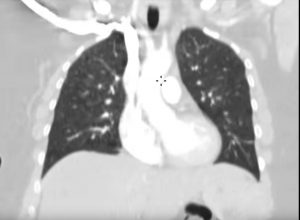 Opportunistic screening for lung cancers is not recommended on coronary CT scans because they are unlikely to yield worthwhile results from incidental findings, a Victorian study has concluded.
Opportunistic screening for lung cancers is not recommended on coronary CT scans because they are unlikely to yield worthwhile results from incidental findings, a Victorian study has concluded.
While pulmonary nodules are common findings on CT coronary angiography, the people undergoing testing for cardiovascular conditions generally have a low risk for lung cancer and 90% would not warrant additional screening, according to study authors led by Dr Christopher Lyne of the Department of Respiratory Medicine, Royal Melbourne Hospital.
In an evaluation of risk profiles for 229 patients referred for coronary CT angiograms at two Melbourne tertiary centres in 2017, they found that even under the most optimistic model only one in ten (23) were eligible for lung cancer screening.
When patients were evaluated according to the PLCOm2012 risk calculator and an age range of 55-80 years, 10% were eligible for lung cancer screening. Using other lung cancer risk models such as the US Preventive Service task Force criteria of 55-80 years of age and 30 pack years smoking history, only 6% of participants were eligible for lung cancer screening.
Dr Lyne and colleagues note that CT coronary angiography is not ideal for detecting pulmonary nodules and neoplasms because it has only a limited field of view (FOV) and can miss the majority of lung neoplasms that occur in the upper zones.
For this reason, full FOV imaging is recommended by those who advocate for opportunistic lung cancer screening in patients undergoing CT screening.
But with 90% of people undergoing coronary CT being ineligible for lung cancer screening, the routine use of full thoracic imaging would result in net harm from repeat scanning, increasing the risk of radiation-induced neoplasms, over-diagnosis and exposing patients to potential complications associated with bronchoscopy and biopsy, they write in the Internal Medicine Journal.
“We have established that this cohort also has a very low prevalence of patients at high risk for lung cancer. Therefore, routine application of full-FOV thoracic imaging during CTCA is not appropriate,” they conclude.
It would be more worthwhile to establish routine smoking cessation interventions to reduce lung cancer risk in the coronary CT angiography population than to implement routine lung cancer screening, they suggest.